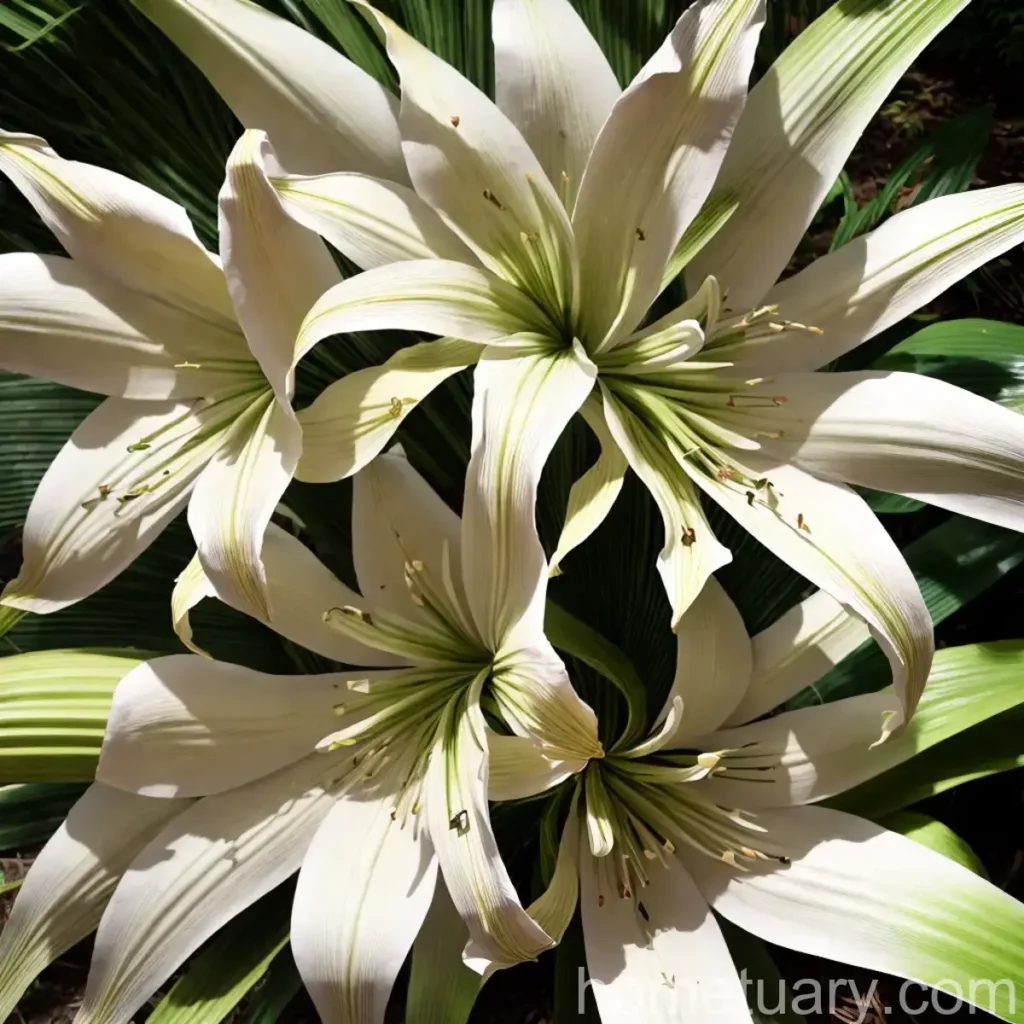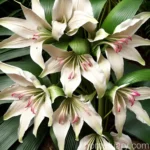Giant Lily (Cardiocrinum Giganteum): A Botanist’s Guide
Plants have always captivated human interest with their beauty, diversity, and unique characteristics. Among the many fascinating plant species, the giant lily (Cardiocrinum giganteum) stands out with its striking appearance and cultural significance. In this comprehensive guide, we will delve into the world of giant lilies, exploring their biology, cultivation, and the rich tapestry of uses and folklore that surround this majestic plant.
What is the Giant Lily (Cardiocrinum giganteum)?
About Cardiocrinum Giganteum
Cardiocrinum giganteum, also known as the giant Himalayan lily, is a species of flowering plant in the family Liliaceae. Native to the Himalayas, southwestern China, and Myanmar, it is highly treasured for its colossal size and captivating fragrance. The giant lily is notable for its towering flowering stem, which can reach impressive heights of up to 8 feet (2.4 meters) or more. The plant’s large, pendulous, trumpet-shaped flowers are a sight to behold, exuding a delightful scent that adds to its allure.
Key Takeaways – Giant Lily (Cardiocrinum Giganteum)
Before we explore the various aspects of giant lily cultivation and care, let’s highlight the key takeaways about this remarkable plant.
- Scientific Name: Cardiocrinum giganteum
- Common Names: Giant lily, giant Himalayan lily
- Native Range: Himalayas, southwestern China, and Myanmar
- Notable Features: Towering flowering stem, large pendulous flowers, and captivating fragrance
- Cultural Significance: Rich history of medicinal, ornamental, and symbolic uses
- Challenges: Susceptibility to certain diseases and pests, specific environmental requirements for optimal growth
With these key takeaways in mind, let’s delve into the intricacies of giant lily cultivation, exploring the plant’s cultural uses, and the intricate care it requires to thrive.
Culture
Uses
The giant lily holds immense cultural and practical significance, offering a wide array of uses that underscore its value to communities and botanical enthusiasts alike.
-
Medicinal Properties: In traditional medicine, various parts of the giant lily, including the bulbs and leaves, have been utilized for their purported therapeutic properties. From treating respiratory ailments to skin disorders, the plant has been a cornerstone of herbal remedies in its native regions.
-
Ornamental Purposes: Renowned for its captivating beauty, the giant lily is a prized ornamental plant in gardens and landscapes around the world. Its impressive stature and enchanting flowers make it a focal point in diverse floral displays.
-
Symbolism: With its majestic presence and eye-catching blooms, the giant lily often symbolizes purity, renewal, and prosperity in cultural traditions and folklore.
-
Cultural Significance: The giant lily holds deep cultural significance in the regions where it is native. It plays a vital role in local traditions, religious ceremonies, and various cultural practices, serving as a symbol of reverence and celebration.
Water
The giant lily thrives in well-drained, consistently moist soil. Adequate water is essential, especially during periods of active growth and flowering. However, it is crucial to avoid waterlogged conditions, which can lead to root rot and other moisture-related issues.
Sunlight
For optimal growth and flowering, the giant lily requires a partially shaded environment. While it can tolerate some direct sunlight, especially during morning hours, prolonged exposure to intense sun may cause leaf scorch and diminish the plant’s overall vigor.
Fertilizer
When it comes to feeding the giant lily, a balanced, slow-release fertilizer applied during the growing season can provide the necessary nutrients for robust growth and prolific flowering. It is important to follow the recommended application rates to avoid over-fertilization, which can have adverse effects on the plant.
Soil
The giant lily thrives in fertile, well-drained soil with a slightly acidic to neutral pH. A rich organic matter, such as compost or well-rotted manure, can be incorporated into the soil to enhance its structure and nutritional content, providing an ideal growing medium for the plant.
Pruning
Pruning requirements for the giant lily are minimal. Deadheading spent flowers can promote continuous blooming, while removing damaged or yellowing foliage helps maintain the plant’s overall health and appearance.
Propagation
The propagation of giant lilies can be achieved through several methods, including seed propagation and division of offsets from mature bulbs.
Seed Propagation
-
Collection: To propagate giant lilies from seeds, collect ripe seed capsules after flowering, ensuring that they have fully matured and started to open.
-
Seed Treatment: Following seed collection, clean the seeds to remove any residual plant material. Some horticulturists recommend a short period of cold stratification to enhance germination rates.
-
Sowing: Plant the seeds in a prepared seedbed or containers, covering them lightly with soil. Regular watering and protection from extreme temperatures are important factors in successful seed germination.
-
Transplanting: Once the seedlings have developed a few sets of true leaves, carefully transplant them into individual pots or a suitable outdoor location, providing adequate spacing for their growth.
Division of Bulbs
-
Timing: Division of giant lily bulbs is best undertaken in late summer to early autumn, when the plant is transitioning into dormancy.
-
Offset Removal: Carefully lift the mature bulbs from the ground and gently separate any offsets or bulbils that have developed along the main bulb. Each offset should have its own roots and shoot for successful propagation.
-
Replanting: Plant the separated offsets in prepared soil at the appropriate depth, ensuring that they receive adequate water and protection as they establish new root systems.
Container Popularity
Due to its striking appearance and manageable size, the giant lily is a popular choice for container gardening, allowing enthusiasts to enjoy its beauty on patios, balconies, and other confined spaces.
-
Container Selection: When cultivating giant lilies in containers, opt for deep, well-draining pots that provide ample room for root development. Ensure that the containers have drainage holes to prevent waterlogging.
-
Soil Considerations: Utilize a high-quality potting mix with good drainage properties, supplemented with organic matter to support the plant’s growth and nutrient needs.
-
Placement: Position the containers in partially shaded areas, protecting the plants from intense sunlight and wind exposure while ensuring they receive adequate light for healthy growth.
Common Diseases
Like many plants, the giant lily is susceptible to certain diseases and infections that can impact its overall health and vitality.
Disease Diagnosis
Common diseases that may affect giant lilies include:
-
Botrytis Blight: This fungal disease can lead to the development of gray mold on the plant’s leaves, stems, and flowers, especially in humid conditions. Proper air circulation and preventive fungicidal treatments can help alleviate this issue.
-
Leaf Spot Diseases: Various pathogens can cause leaf spot diseases in giant lilies, leading to unsightly blemishes on the foliage. Good sanitation practices, including removal of affected leaves, can mitigate the spread of these diseases.
-
Viral Infections: Viruses can affect the overall vigor and appearance of giant lilies, often causing distorted growth, mottled foliage, and reduced flowering. Proper management through sanitation and pest control can aid in disease prevention.
-
Root Rots: Excessive moisture and poor drainage can create favorable conditions for root rot pathogens, compromising the plant’s root system and overall health. Implementing proper watering practices and maintaining well-drained soil are crucial in preventing this issue.
Disease Management
To effectively manage and prevent diseases in giant lilies, it is essential to adopt a proactive approach, emphasizing cultural practices and disease-resistant cultivars. Regular monitoring for symptoms and prompt intervention can help safeguard the plant’s well-being.
Common Pests
Pests can pose significant challenges to giant lily cultivation, causing damage to the plant’s foliage, flowers, and overall growth. Some of the common pests that may target giant lilies include:
-
Aphids: These small, sap-sucking insects can infest the tender parts of the plant, leading to distorted growth and honeydew secretion. Natural predators and insecticidal treatments can assist in aphid control.
-
Lily Leaf Beetles: The larvae and adults of these beetles can cause extensive defoliation, impacting the plant’s aesthetic appeal and overall vigor. Vigilant monitoring and targeted pesticide applications can aid in beetle management.
-
Slugs and Snails: These mollusks can feed on the foliage and flowers of giant lilies, leaving behind characteristic feeding damage. Use of physical barriers and biological control methods can help minimize their impact.
-
Spider Mites: These tiny arachnids can cause stippling and webbing on the plant’s leaves, compromising its health and appearance. Regular foliage inspection and appropriate acaricidal treatments can aid in spider mite control.
Botanist’s Tips
As an experienced botanist with a passion for giant lilies, I have gathered a few tips to help enthusiasts and gardeners successfully cultivate and care for these magnificent plants.
-
Environmental Considerations: When selecting a location for planting giant lilies, consider the specific environmental requirements of the species, including soil, moisture, and light conditions.
-
Proactive Disease Management: Implement a proactive disease management strategy, focusing on cultural practices, sanitation, and targeted interventions to minimize disease impact.
-
Pest Monitoring: Regularly monitor the plants for signs of pest activity, promptly addressing any infestations to prevent extensive damage.
-
Fertility Management: Maintain a balanced fertility program, ensuring that the plants receive adequate nutrients for robust growth and flowering without the risk of over-fertilization.
-
Pruning Techniques: Practice prudent pruning, removing spent flowers and damaged foliage to maintain the plant’s health and appearance.
-
Cultural Significance: Embrace the cultural significance of giant lilies, exploring their traditional uses, symbolism, and rich history in their native regions.
Fun Facts
To further enrich our understanding and appreciation of giant lilies, let’s explore some intriguing and lesser-known facts about these remarkable plants.
-
The giant lily (Cardiocrinum giganteum) is renowned for its remarkable ability to produce immense flowering stems, often exceeding the height of the average adult.
-
In addition to its captivating beauty, the giant lily is celebrated for its enchanting fragrance, which permeates the surrounding environment with a delightful aroma.
-
The plant’s large, pendulous flowers, with their prominent stamens and pistils, serve as a vital resource for pollinators, attracting a diverse array of insects that aid in the plant’s reproductive cycle.
-
With a rich history of traditional uses, folklore, and cultural symbolism, giant lilies continue to inspire and captivate people around the world, fostering a deep appreciation for botanical diversity and cultural heritage.
Links to External Resources
For further exploration of giant lilies and related topics, consider the following resources:
- Royal Horticultural Society: Cardiocrinum giganteum
- Missouri Botanical Garden: Cardiocrinum giganteum
- North American Lily Society
- American Horticultural Society
Conclusion
The giant lily (Cardiocrinum giganteum) stands as a testament to nature’s splendor, captivating enthusiasts and botanists alike with its towering stature, enchanting blooms, and cultural significance. As we navigate the intricacies of its cultivation, care, and historical significance, we discover a plant that not only delights the senses but also embodies the rich tapestry of botanical diversity and human connection to the natural world. By embracing the knowledge and appreciation of plants like the giant lily, we continue to nourish our understanding of the natural world, fostering a deep-rooted reverence for the wonders of flora and the stories they tell through the ages.















